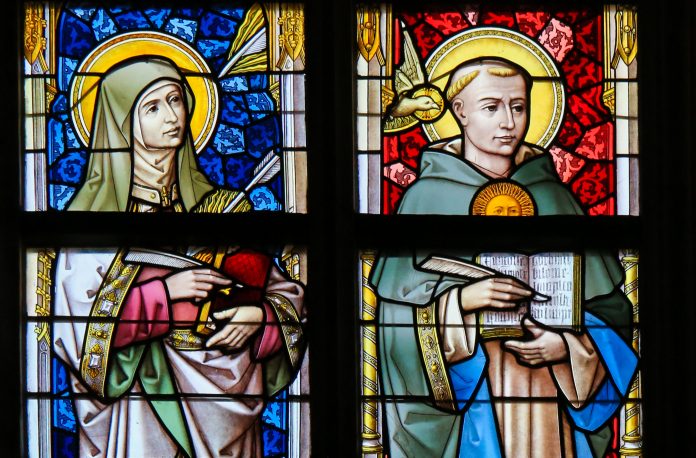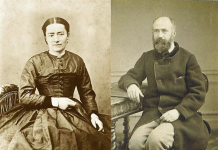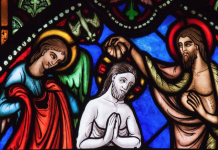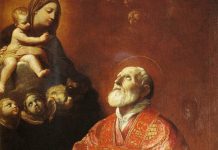
by Kate Ristow
See the end of this article for a puzzle activity that will help students review the biographies of St. John XXIII and St. John Paul II.
When Pope Francis elevated two extraordinary popes to sainthood last April, many religious education programs were so caught up in end-of-the-year activities that there was no time to focus on these historic canonizations. However, as we look ahead to November, the month when the Church traditionally honors all the saints, let’s help students honor St. John XXIII and St. John Paul II. These two men left a lasting legacy on both Church and world history. Our students deserve to know them and why they are important.
Give each student a copy of the profiles provided here and have them read the profiles carefully. As you discuss the lives of these saints, use the material in the rest of this article to teach about the day the popes were canonized and their significance. Choose one or more activities for the students to do, or explain the different activities and allow students, working independently or as teams, to choose the activity they prefer to do.
Meet St. John XXIII
Angelo Roncalli was born in 1881 in a small town in Northern Italy. His family was so poor that Angelo often walked barefoot to school, carrying his shoes so that the leather would not wear out.
Although most of his neighbors were farmers, Angelo chose to study for the priesthood. After he was ordained, he was sent to Rome to study Church law. During World War I, Fr. Angelo served as a stretcher-bearer for the Italian army. The evil of war saddened him. Later he became a papal diplomat, representing the pope in Turkey, Greece, and France. He worked for peaceful solutions and the rights of the poor. As an archbishop, he worked with other leaders to save many Jewish people from the German death camps of World War II. Not long after, he was named the Cardinal of Venice.
Elected pope in 1958, Angelo Roncalli chose to be known as John, his father’s name. He became known all over the world as “Good Pope John” because of his warmth and humor. On the day of his election, none of the white cassocks that had been made for the new pope fit him. Instead, he wore a garment held together by safety pins, but he greeted the crowds who cheered him with a smile that was wider than he was!
Pope John XXIII visited hospitals, prisons, and orphanages, treating everyone with love. It is said that he sometimes dressed as a regular priest so he could sneak out of the Vatican at night to walk around Rome and visit with everyone he met.
Pope John XXIII wrote two important Church letters, called encyclicals: Mother and Teacher (1961) and Peace on Earth (1963).
We remember Pope John XXIII best for convening an ecumenical council called the Second Vatican Council . More than 2,000 bishops, theologians, and other experts gathered to renew the Church. The council had four major sessions from 1962 to 1965; its work helped guide the Church in the modern world.
Saint John XXIII died in 1963, but his work and spirit live on today. We celebrate his feast day on October 11, the anniversary of the date he opened the Second Vatican Council. Saint John XXIII’s life teaches us to cooperate with the Holy Spirit, as he did, so that we can respond to God’s plan for each of us.
Meet St. John Paul II
Karol Wojtyla (Voy-tee’-wah) was born in Poland in 1920. He studied drama at college, but his dream of becoming an actor was cut short by World War II.
Karol decided to become a priest, but had to study in secret. When the war ended, the seminary reopened and Karol completed his studies. He was ordained in 1946 and was sent to Rome to earn a doctorate in theology. He returned to Poland as a parish priest. He was made a bishop and, later, he became the Cardinal of Krakow.
Karol Wojtyla participated in the Second Vatican Council and contributed to several of the council’s important documents. He was named a cardinal in 1967 by Pope Paul VI.
Cardinal Wojtyla made history in 1978 when he was elected the first non-Italian pope in more than 400 years. He took the name John Paul II. He was the most active pope the world had ever seen. He visited 129 countries. He reached out to people of all faiths. He established World Youth Day. On a 1979 visit to New York, young people chanted, “John Paul II, we love you!” The pope smiled and chanted back, “John Paul II, he loves you!”
In 1981, Pope John Paul II was the victim of an attempted assassination. Speaking from his hospital bed, the pope forgave the man who shot him. Two years later, he visited the man in prison to pray with him.
Pope John Paul II wrote over 50 major Church documents, teaching on topics such as the Eucharist, social justice, mercy, and unity. He oversaw the publication of the Catechism of the Catholic Church, the first major presentation of the Church’s teachings since the Roman Catechism in 1566.
Pope John Paul II canonized 482 saints, more than any other pope. By honoring so many men and women who showed their love for God in different ways, Pope John Paul II reminds us that we are all called to be saints.
We remember St. John Paul II as the greatest missionary of the modern Church. We celebrate his feast day on October 22, the anniversary of the day he was inaugurated pope. During his 27-year reign as pope, he shared his faith in Jesus with his words, actions, heart, and soul. He asks us to do the same—to show everyone that Jesus makes all the difference in our lives.
The Day of Canonization
Not even a damp and drizzling April day could mute the joyful celebration of the 500,000 faithful pilgrims who gathered near St. Peter’s Square in Rome to hear Pope Francis proclaim in Latin, “We declare and define Blessed John XXIII and John Paul II to (be) saints.”
Some newspapers called this historic event a “four pope day” because in addition to the reigning Holy Father, Pope Francis, canonizing two popes at a single ceremony for the first time in history, another pope was in attendance as well: Pope Emeritus Benedict XVI, the first Bishop of Rome to retire from office since the Middle Ages.
Before the canonization Mass began, Pope Francis embraced Pope Emeritus Benedict, who had stepped aside as the Holy Father in 2013 because he felt the weaknesses of age limited his ability to be the kind of leader the Church needs at this time in history. Instead, he devotes himself to a life of prayer for the Church and the People of God.
Pope Emeritus Benedict XIV concelebrated the Mass with Pope Francis, along with approximately 150 cardinals, 700 bishops, and 600 priests. Also in attendance were delegations from more than 100 countries and at least 24 heads of state. Large crowds from Poland (St. John Paul II’s birthplace) and northern Italy (the childhood home of St. John XXIII) were also present, waving official flags and homemade signs from their native countries.
Divine Mercy Sunday was chosen by Pope Francis for the canonization of these men. This worldwide Church feast day is celebrated a week after Easter (also known as the Second Sunday of Easter). The feast was established by Pope John Paul II in 2000. Each year, on Divine Mercy Sunday, we remember that God showed mercy and love for all people by sending his only Son, Jesus, to sacrifice his life on the cross to save us from sin and death. From the beginning of his reign, Pope Francis has emphasized his trust in God’s mercy and forgiveness, so it is not surprising that he would choose this date to canonize the two popes.
Their Significance
Although the reigns of these two popes were two decades apart, they are connected in many ways. Pope Francis called them “priests, bishops, and popes of the twentieth century. They lived through the tragic events of that century, but were not overwhelmed by them. For them, God was more powerful.”
By convening the Second Vatican Council, Pope John XXIII set in motion the modernization and renewal of the Church, and it was Pope John Paul II who shaped those reforms and helped people understand the deeper meaning of the council. Both saints made social justice and human dignity a priority. This emphasis continues today in Pope Francis.
The word pope is adapted from the ancient Roman title for emperors, pontifex, which means “bridge builder.” While it is not one of the official titles for the Holy Father (although @pontifex is Pope Francis’ Twitter handle), it perfectly describes the work of our two new saints. Saint John XXIII and St. John Paul II were bridge builders—building a sturdy structure that connects the Church of the past to the Church of today and tomorrow.
Activities
* On Divine Mercy Sunday, we remember God’s mercy and love and dedicate ourselves to showing love, kindness, and forgiveness to everyone we meet. Invite students to work with a partner to identify two ways they can share God’s loving kindness with others, as our new saints did in life.
* Challenge older students to use the internet to find photographs taken on April 27, 2014, the day Pope Francis canonized St. John the XXIII and St. John Paul II. Have students use the photographs to assemble an album, with a caption describing what is happening in each picture.
* It is common for a bishop, cardinal, or pope to choose a motto as a description of his ministry or a guiding principle for his life. Saint John XXIII’s motto was “Obedience and Peace.” Saint John Paul II’s motto was “Totally Yours.” (That was Pope John Paul II’s way of expressing his devotion to the Blessed Virgin Mary.) Have students work in groups, and assign one of the mottos to each group. Have students describe how the pope lived his motto through his vocation.
* Have students use YouTube, Facebook, and other internet sites to find video clips of different World Youth Days. Show the clips to the class and invite comments on what it would be like to attend this event. If possible, arrange for someone from your diocesan office to visit your class to discuss the diocese’s participation in WYD.
* Students’ parents and grandparents may have vivid memories of one or both of these saints. Encourage the young people to interview family members to see what they recall about either of the popes and why their memories are important for them.
* Since Pope John Paul II called for the first WYD celebrated in Rome in 1986, there have been 13 WYDs. Encourage students to research previous WYDs to determine the location, date, and scriptural theme for each. For example, the next WYD will be in Krakow, Poland in 2016. The theme is “Blessed are the merciful, for they will receive mercy” (Matthew 5:7). The USCCB website has an excellent link to World Youth Day information.
* Over 70 popes have been canonized saints. However, rather than having students select and research popes who were canonized saints, focus their attention on two other saints who were popes and who emphasized renewal and reform the way St. John XXIII and St. John Paul II did: St. Gregory the Great and St. Leo the Great. Have students work in small groups to prepare oral presentations on the saint they are assigned.
* Part of the canonization ceremony was the praying of the Litany of the Saints, to which the names of our two newest saints were added. Introduce your class to this prayer and pray it with them, inserting St. John XXIII’s name and St. John Paul II’s names in the invocations. Afterward, ask volunteers to share why they would pray to either of the new saints and what they would ask in their prayers.
Kate Ristow, Contributing Editor to CATECHIST, has worked in Catholic publishing for over 30 years as a national speaker and writer, building on a wealth of experience in the religious formation of children and catechists in both parish and Catholic school programs.
Puzzle Review of St. John XXIII and St. John Paul II
Give each student a sheet of tagboard, a glue stick, a pencil, and scissors. Have students make two columns on the tagboard and place the name ST. JOHN XXIII at the top of one column and ST. JOHN PAUL II at the top of the other column.
Give each student a copy of the biographical statements of St. John XXIII [CLICK HERE] and St. John Paul II [CLICK HERE]. Have students cut out the personal statements (following the dotted lines), thoroughly mix all the statements together, and glue each one onto the tagboard under the name of the saint whose voice is heard in the statement.
Have students complete the statements about why each saint is important and glue that at the bottom of the respective column.
Copyright 2014, Bayard, Inc. All rights reserved. This article is protected by United States copyright and other intellectual property laws and may not be reproduced, rewritten, distributed, redisseminated, transmitted, displayed, published or broadcast, directly or indirectly, in any medium without the prior written permission of Bayard, Inc.
This article was written by the Catechist Staff and appeared in Catechist magazine, February 2014.
Image Credit: Shutter Stock 544541167




